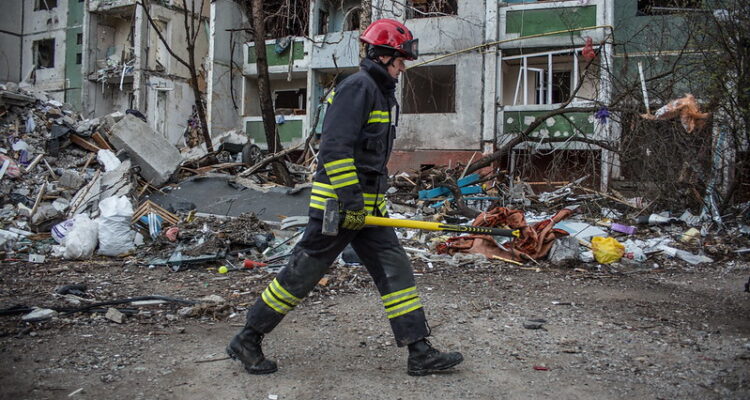Yaroslav Trofimov is the chief foreign affairs correspondent for the Wall Street Journal and author of the new book Our Enemies Will Vanish: The Russian Invasion and Ukraine’s War of Independence.
Trofimov is a veteran journalist who has covered conflicts around the world — he also happens to have been born and raised in Ukraine. In the book, he offers a first-hand account of the war and explains the conflict from a Ukrainian perspective. The book comes out tomorrow, January 9. It is a must-read for anyone who wants a deeper understanding of how the war in Ukraine evolved — and where it may be headed next.
I caught up with Trofimov last week, amid news of a major prisoner swap between Ukraine and Russia. I begin our interview by asking him about the significance of prisoner exchanges and what it means, if anything, for the trajectory of the conflict. We also discuss the recent major missile barrage on Kyiv in the first week of January. This was the single largest attack since the start of the war and it elicited a significant response from Ukraine, which hit targets inside Russia.
In the excerpt below, Trofimov explains that Putin is betting that Republicans in Congress will prevent a new Ukraine funding bill that would enable the resupply of missile defense systems. Accordingly, Russia is intensifying its missile attacks on Kyiv and other cities in order to wear out Ukraine’s air defenses.
The transcript has been edited for clarity.
Mark Leon Goldberg: Why do you suspect that Russia launched this new heavy missile attack volley when it did at the start of the year?
Yaroslav Trofimov: In part it is to remind Ukraine of its vulnerability. In part, it has a very clear purpose of trying to exhaust the Ukrainian air defenses. And let’s just look at the broader picture. So throughout this whole war, Russia has not been able to enjoy air superiority primacy anywhere in Ukraine except in Mariupol. In Mariupol, it flattened the city using dumb bombs, dropped a bomb on a theater sheltering children and dropped bombs on the hospital. It really was, in terms of visual landscape, not that different from what we are seeing in Gaza now. But elsewhere in Ukraine, the casualties are much more limited because Russian planes were being shot down.
So Russia’s biggest goal in this war is to dent or weaken Ukraine air defenses. Ukraine’s Soviet systems, the S-300, pretty much have run out of missiles because Ukraine does not make them and there’s no where to buy them except Russia. And the Western systems, like Patriot Missiles, are expensive. Russia is betting that Ukraine is going to run out of these missiles, and with no American funding forthcoming, Russia would then destroy the missile defense batteries themselves, then finally will have a free hand drop lots of dumb bombs on Ukrainian cities.
Mark Leon Goldberg: Wow. So really, they’re just doing it to exhaust the existing stockpiles of Ukrainian air defense on the assumption that Congress won’t re-up authorization for funding new air defenses?
Yaroslav Trofimov: The manner in which Russia is conducting some of these very intense barrages are combined with drone attacks also aimed to destroy the actual Patriot launchers. Nobody knows whether they’ve had much success. The Russians have claimed success. Ukraine denied it. It’s all shrouded in secrecy.
So far the Patriots are working, but if you look at the list of targets that Russians had in last barrage, they’re also trying to hit Ukrainian military industries — or what they thought were locations where Ukrainian military industries are. Ukraine, understanding that there is a threat of a cut off in American aid, is trying to localize as much production as possible in Ukraine.
You know, Ukraine before the war was a big manufacture of all sorts of weapons, tanks, helicopter engines, plane engines and missiles and and other things. And so a lot of the Ukrainian government effort now is to make domestically produced drones and missiles, partly because Ukraine is not allowed to use Western weapons to strike targets inside Russia. It’s only allowed to use these American and Western provided weapons to strike targets inside occupied Ukraine. So it needs to respond to fire coming from cross border.
Mark Leon Goldberg: Your answer really harkens to a recurring theme in your book, which is that Russia seems to have an unlimited supply of ammunition while Ukraine is really working with rather limited resources, at least in comparison to Russia. Russia has this overwhelming ability to send both missiles and also men to the front, whereas Ukraine is rather limited. And now we see the the next iteration of this, in which Russia has apparently acquired missiles from North Korea. What do you see as the significance of that development?
The full transcript is available for newsletter subscribers. The podcast episode is freely available on Spotify, Apple Podcasts or anywhere you get podcasts.
